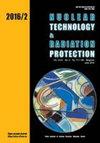Dual number automatic differentiation as applied to two-group cross-section uncertainty propagation
IF 0.9
4区 工程技术
Q3 NUCLEAR SCIENCE & TECHNOLOGY
引用次数: 1
Abstract
This work addresses the problem of propagating uncertainty from group-wise neutron cross-sections to the results of neutronics diffusion calculations. Automatic differentiation based on dual number arithmetic was applied to uncertainty propagation in the framework of local sensitivity analysis. As an illustration, we consider a two-group diffusion problem in an infinite medium, which has a solution in a closed form. We employ automatic differentiation in conjunction with the sandwich formula for uncertainty propagation in three ways. Firstly, by evaluating the analytical expression for the multiplication factor using dual number arithmetic. Then, by solving the diffusion problem with the power iteration algorithm and the algebra of dual matrices. Finally, automatic differentiation is used to calculate the partial derivatives of the production and loss operators in the perturbation formula from the adjoint-weighted technique. The numerical solution of the diffusion problem is verified against the analytical formulas and the results of the uncertainty calculations are compared with those from the global sensitivity analysis approach. The uncertainty values obtained in this work differ from values given in the literature by less than 1?10?5.应用对偶数自动微分法求解两组截面不确定性传播
这项工作解决了将不确定性从群中子截面传播到中子扩散计算结果的问题。将基于对偶数算法的自动微分应用于局部灵敏度分析框架下的不确定性传播。作为一个例子,我们考虑了无限介质中的两群扩散问题,该问题的解是封闭形式的。我们将自动微分与三明治公式相结合,以三种方式进行不确定性传播。首先,利用对偶数算法求出乘法因子的解析表达式。然后,利用幂迭代算法和对偶矩阵代数求解扩散问题。最后,采用伴随加权法对扰动公式中的产生算子和损失算子的偏导数进行自动微分计算。用解析公式验证了扩散问题的数值解,并将不确定性计算结果与全局灵敏度分析方法的计算结果进行了比较。在这项工作中得到的不确定度值与文献中给出的值相差小于1 × 10 × 5。
本文章由计算机程序翻译,如有差异,请以英文原文为准。
求助全文
约1分钟内获得全文
求助全文
来源期刊

Nuclear Technology & Radiation Protection
NUCLEAR SCIENCE & TECHNOLOGY-
CiteScore
2.00
自引率
41.70%
发文量
10
审稿时长
6-12 weeks
期刊介绍:
Nuclear Technology & Radiation Protection is an international scientific journal covering the wide range of disciplines involved in nuclear science and technology as well as in the field of radiation protection. The journal is open for scientific papers, short papers, review articles, and technical papers dealing with nuclear power, research reactors, accelerators, nuclear materials, waste management, radiation measurements, and environmental problems. However, basic reactor physics and design, particle and radiation transport theory, and development of numerical methods and codes will also be important aspects of the editorial policy.
 求助内容:
求助内容: 应助结果提醒方式:
应助结果提醒方式:


